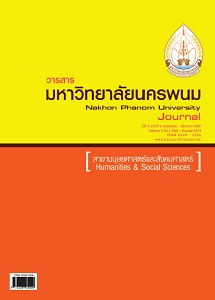การประยุกต์ใช้เทคนิคบัญชีต้นทุนการไหลวัสดุเพื่อลดความสูญเสีย ในกระบวนการผลิตลำไยอบแห้ง
Main Article Content
Abstract
การวิเคราะห์บัญชีต้นทุนการไหลของวัสดุเป็นระบบบัญชีสำหรับสิ่งแวดล้อมที่มีจุดมุ่งหมายเพื่อประเมินและลดผลกระทบด้าน สิ่งแวดล้อมไปพร้อมกับลดต้นทุนของผลิตภัณฑ์ งานวิจัยนี้มีจุดประสงค์ประยุกต์ใช้เทคนิคบัญชีต้นทุนการไหลวัสดุเพื่อลดความสูญเสีย ในกระบวนการผลิตลำไยอบแห้งและเพื่อถ่ายทอดองค์ความรู้ในภาคอุตสาหกรรม จากผลการวิเคราะห์บัญชีต้นทุนการไหลของวัสดุใน ผลิตภัณฑ์ลำไยอบแห้งเนื้อสีทองพบว่า ต้นทุนผลิตภัณฑ์ประกอบด้วยต้นทุนวัตถุดิบร้อยละ 71.22 ต้นทุนแรงงานร้อยละ 23.95 ต้นทุน การจัดการน้ำทิ้งและเศษเหลือร้อยละ 3.86 และต้นทุนค่าไฟฟ้าและเชื้อเพลิงร้อยละ 0.97 และพบว่ามีต้นทุนที่ก่อให้เกิดมูลค่ากับ ผลิตภัณฑ์เพียงร้อยละ 19.76 เป็นต้นทุนที่ไม่ก่อให้เกิดมูลค่ากับผลิตภัณฑ์ถึงร้อยละ 80.24 ประกอบด้วยความสูญเสียจากต้นทุน ในส่วนของวัตถุดิบลำไยร้อยละ 57.15 ระบบการผลิต (ค่าแรงงาน) ร้อยละ 18.60 ค่าไฟฟ้าและพลังงานร้อยละ 0.63 และการจัด การสิ่งแวดล้อมร้อยละ 3.86 จากการวิเคราะห์หาสาเหตุของความสูญเสียสรุปวิธีแก้ปัญหา 3 แนวทางดังนี้ 1) ลดต้นทุนความสูญเสีย จากระบบการผลิต (ค่าแรงงาน) โดยใช้เครื่องคว้านเมล็ดลำไยอัตโนมัติแทนแรงงานคน สามารถลดต้นทุนรวมของผลิตภัณฑ์ลงได้ 4,138.8 บาทต่อการผลิตลำไยอบแห้ง 1,200 กก. ลงทุนเครื่องจักร 320,000 บาท มีระยะคืนทุน 1 ปี 7 เดือน 2) ลดต้นทุนความ สูญเสียด้านพลังงานด้วยการเพิ่มประสิทธิภาพเตาอบลำไยอบแห้งสีทองสามารถลดเวลาการอบจาก 12 ชั่วโมงเหลือ 10.8 ชั่วโมง และ 3) การลดต้นทุนความสูญเสียด้านการจัดการสิ่งแวดล้อม ด้วยแนวทางแปลงเศษเมล็ดลำไยให้กลายเป็นผลิตภัณฑ์ใหม่ที่มีคุณภาพและ มีมูลค่าสูงขึ้น
Material Flow Cost Accounting (MFCA), one of the environmental management accounting methods aims to assess and reduce both environmental impact and product costs. The purpose of this study was to apply MFCA to reduce loss in the process of manufacturing dried longan and to transfer the MFCA body of knowledge to the industrial sector. From the results of MFCA in the golden dried longan product, it was found that the production costs were composed of 71.22% raw material cost, 23.95% labor cost, 3.86% wastewater and the residue management cost, and 0.97% electricity and fuel cost. And it was found that the cost that produced the value of product per se had only 19.76% while the cost that did not produce the value of product reached 80.24%. This cost included loss of 57.15% longan raw material, 18.60% labor, 0.63% electricity and energy, and 3.86% environmental management. From the analysis of causes of loss, three approaches to the problem solution were concluded as follows: 1) Reducing the loss cost of labor from the manufacturing system by using an automatic machine for taking out longan seeds. It is able to decrease the 4,138.8 baht production cost per manufacturing 1,200 kilos of dried longan. The payback period for investment of 320,000 baht in a machine will take 1 year and 7 months. 2) Reducing the loss cost of energy by increasing the efficiency of a batch dryer of golden longan which is able to reduce drying time from 12 hours to 10.8 hours. And 3) reducing the loss cost of environmental management by changing from longan seeds to value-added novel quality products.


